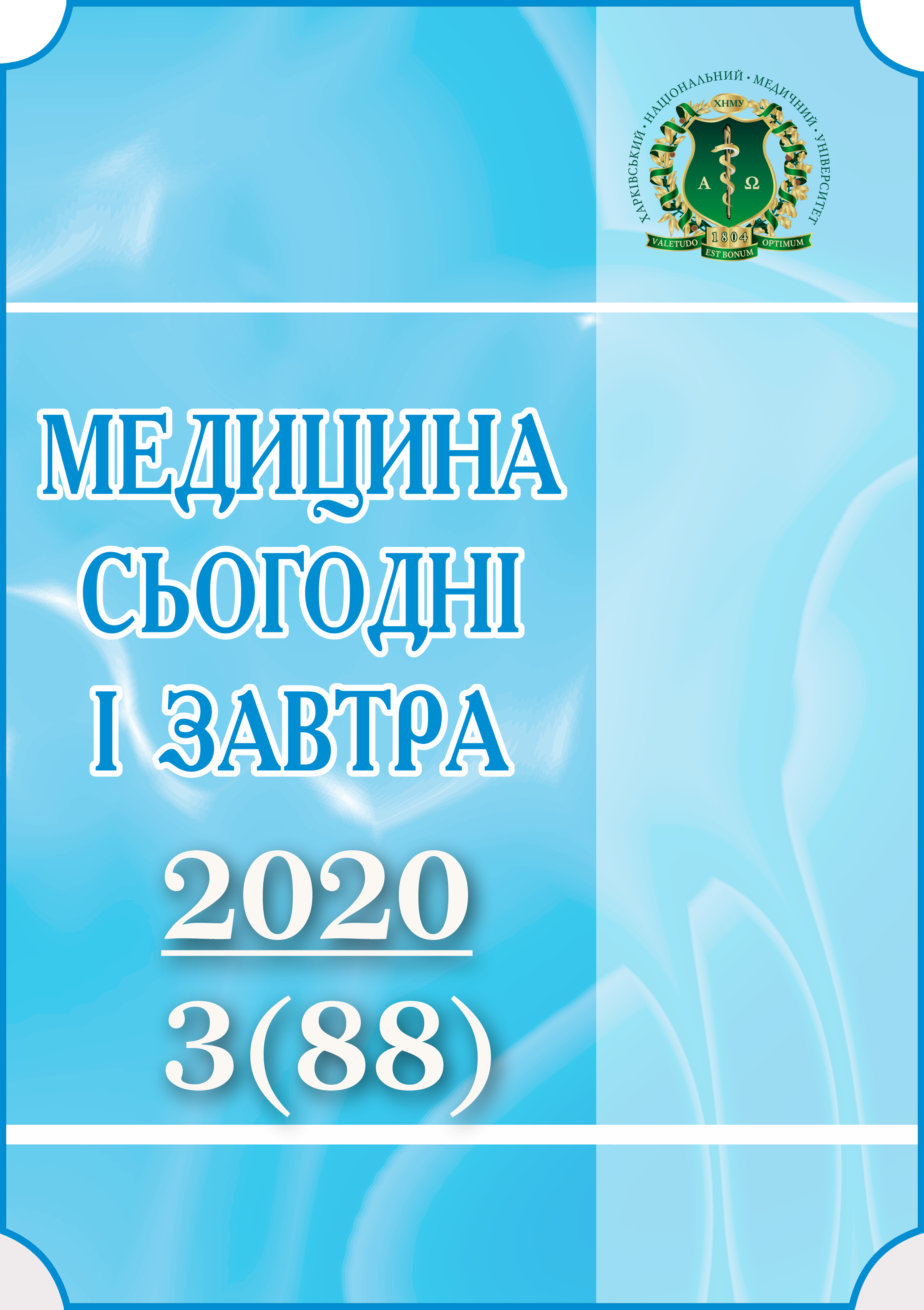Abstract
200 hemispheres of the brain of people who died from diseases not related to brain pathology were studied. Morphometric method was used and statistical analysis was completed. It was found out that the width of the right and left hemispheres of the brain in both men and women of brachycranial skull type is slightly greater than of mesocranial and dolichocranial ones. Men and women with dolichocranial skull type have the width of the left hemisphere greater than the right one. Men have the width of the left and right hemispheres greater than women. The limits of individual variability of brain hemispheres’ and occipital lobes’ width have been determined taking into account the type of skull and sex. The largest indicators of the cerebral hemispheres’ width are the next: men of the brachycranial skull type have the right hemisphere’s width of the 70.6-10^-3 m, left one of the 71.4•103 m width; the women of the brachycranial skull type have the right hemispheres’ width of the 63.4-10^-3 m and the left one of the 63.8 103 m, the women of the mesocranial skull type have the left hemisphere’s width of 63.7•103 m. The smallest indicators of the cerebral hemispheres’ width are: men of the dolichocranial skull type have the width of the right hemisphere 44•103 m, of the left one of the dolichocranial skull type and of the brachycranial skull type have the width 43.8•103 m; women of the dolichocranial skull type have the width of the right hemisphere 38.5•103 m, left one of 42.5•10^-3. The largest indicators of the occipital lobes’ width are: men of the brachycranial skull type have the width of the right hemisphere 56•103 m, men of the mesocranial skull type have the width of the left hemisphere 65•10 3 m; women of the dolichocranial skull type have the right hemispheres’ width 58-10^-3 m, of mesocranial skull type have the left one is of 63•10^-3 m and of dolichocranial it is of 62.5•103 m. The smallest indicators of the occipital lobes’ width are: men of the dolichocranial skull type have the width of the right lobe 41•103 m, of mesocranial and brachycranial types it is 42•10 3 m, the width of the left lobe in men with dolichocranial skull type of 38•103 m; women of the mesocranial skull type have the right lobe’s width of 36•103 m, the left one of dolichocranial skull type it is of 34•10^-3 m.
Keywords: endbrain, occipital lobe, individual anatomical variability.
References
Boholepova, I.N., Krotenkova, M.V., Malofeeva, L.I., Konovalov, R.N., & Ahapov, PA. (2010). Arkhitektonika kory mozha cheloveka: MRT-atlas [The Architectonies of the Human Cortex: MRI Atlas], Moscow: Atmosfera, 216 p. [in Russian].
Baibakov, S.Ye., Haivoronskii, I.V., & Haivoronskii, A.I. (2009). Sravnitelnaia kharakteristika morfometricheskikh parametrov holovnoho mozha u vzrosloho cheloveka v period zreloho vozrasta (po dannym mahnitno-rezonansnoi tomohrafii) [Comparative characteristics of the morphometric parameters of the brain in an adult in adulthood (according to magnetic resonance imaging)]. Vestnik Sankt-Peterburhskoho universiteta. Seriia 11. Meditsina - Vestnik of Saint-Petersburg University. Series 11. Medicine, No.1, pp. 111-117 [in Russian].
Timoshenko, O.R. (2012). Varianty anatomicheskoi izmenchivosti stroieniia i formy cherepa [Variants of anatomical variability of the structure and shape of the skull]. Ukrainskyi morfolohichnyi almanakh - Ukrainian Morphological Almanac, vol. 10, No.1, pp. 133-134 [in Russian].
Tukhtaboiev, I.T. (2003). Vozrastnyie i individualnyie izmeneniiatsitoarkhitektoniki korkovykh polei 17, 18, 19 zatylochnoi oblasti v levom i pravom polushariiakh mozha cheloveka [Age-related and individual changes in the cytoarchitectonics of the cortical fields 17, 18, 19 of the occipital part in the left and right hemispheres of the human brain]. Doctor’s thesis. Moscow, 215 p. [in Russian].
Zimushkina, N.A., Kosareva, P.V., Cherkasova, V.H., & Khorinko V.R (2013). Histolohicheskaia i morfometricheskaia kharakteristika hippokampa v razlichnyie vozrastnyie periody [Histological and morphometric characteristics of the hippocampus at different age periods], Permskii meditsinskii zhurnal- Perm Medical Journal, vol. 30, № 1, pp. 98-103 [in Russian],
Lavrov, V.V. (2010). Mezhpolushamaia asimmetriia i opoznaniie nepolnykh izobrazhenii pri izmenenii emotsionalnoho sostoianiia [Interhemispheric asymmetry and recognition of incomplete images when emotional state changes]. Sensornye sistemy - Sensory Systems, vol. 24, No.1, pp. 41-50 [in Russian].
Tsekhmistrenko, T.A., Vasilieva, V.A., & Shumeiko, N.S. (2012). Mezhpolushamaia asimmetriia v razvitii somatosensomoi lobnoi i zritelnoi kory bolshoho mozha cheloveka v postnatalnom ontoheneze [Interhemispheric asymmetry in the development of the somatosensory frontal and visual cortex of the human large brain in postnatal ontogenesis]. Astrahanskii meditsinskii zhurnal - Astrakhan Medical Journal, No.4, pp. 264-266 [in Russian].
Cardin, V., &Smith, A.T. (2010). Sensitivity of human visual and vestibular cortical regions to egomotion-compatible visual stimulation. Cereb. Cortex, vol. 20, No.8, pp. 1964-1973. DOI: 10.1093/cercor/bhp268. PMID: 20034998.
Haines, D. (2008). Neiroanatomiia: atlas struktur, srezov i sistem [Neuroanatomy: an atlas of structures, slices and systems]. (Bobylova, M.Yu., Trans.). Moscow: Lohosfera, 344 p. [In Russian].
Johnson, C.L., McGarry, M.D., Gharibans, A.A., Weaver, J.B., Paulsen, K.D., Wang, H., et al. (2013). Local mechanical properties of white matter structures in the human brain. Neuroimage, vol. 79, pp. 145-152. DOI: 10.1016/j.neuroimage.2013.04.089. PMID: 23644001.
Kostilenko, Yu.P., & Boiahina, O.D. (2015). Printsip ustroistva bolshoho mozha cheloveka (analiticheskii obzor literatury) [Principle of the human endbrain arrangement (analytical review of literanure)]. Medytsyna sohodni i zavtra - Medicine Today and Tomorrow, 3(68), pp. 10-18. https://msz.knmu.edu.ua/article/view/526 [in Russian].
Kholamov, A.I. (2014). Metodika provedeniia kraniolohicheskoho issledovaniia s pomoshchiu prohrammnoho obespecheniia multispiralnoho kompiutemoho tomohrafa [Craniological examination technique using multispiral computed tomography software]. Molodoi uchenyi - Young Scientist, No.14, pp. 78-80 [in Russian].

